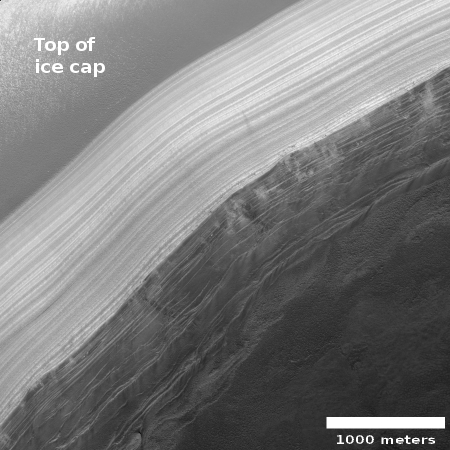The edge of Mars’ north polar ice cap
Cool image time! The photo to the right, cropped and reduced to post here, was taken on December 29, 2019 by the high resolution camera of Mars Reconnaissance Orbiter (MRO) and shows the many-layered scarp face of the Martian north polar ice cap. I have also rotated the image so that north is at the top. The overall height of this scarp is quite high, more than 3,500 feet.
There are a number of very cool features in this image. For example, note what at first look like puffs of clouds just below the contact between the bright and dark layers. I count almost two dozen, with the largest near the center. They are not cloud puffs, however, but areas scoured by past avalanches. According to Patricio Becerra at the University of Bern in Switzerland,
An image from a few years ago shows evidence for the same patches, so they likely happened a while back. When the avalanches or “block falls” occur, they scour the Basal Unit [the dark layer] and break up the exposed surface, causing a brighter/cloudier appearance of the ground than the undisturbed parts.
Avalanches on the scarps of the North Pole icecap occur in great numbers at the beginning of every Martian summer. As sunlight hits the scarp, it causes the carbon dioxide frost layer that settled on the cap during the winter to sublimate away as vapor, and like the freeze-melt cycle on Earth, this sublimation disturbs any unstable ice boulders on the scarp face.
During the early Martian summer, images from MRO routinely capture many such avalanches. Scientists think there could be hundreds to thousands every summer. In many ways, this is similar to the large pieces of ice that routinely calf off the foot of glaciers here on Earth, and that tourists take cruise ships to see in the inside passage of Alaska.
For context, the overview map below indicates with a gold cross where on the icecap’s edge this image is located. The red and pink areas indicate the vast dune fields that surround the icecap.
» Read more
Cool image time! The photo to the right, cropped and reduced to post here, was taken on December 29, 2019 by the high resolution camera of Mars Reconnaissance Orbiter (MRO) and shows the many-layered scarp face of the Martian north polar ice cap. I have also rotated the image so that north is at the top. The overall height of this scarp is quite high, more than 3,500 feet.
There are a number of very cool features in this image. For example, note what at first look like puffs of clouds just below the contact between the bright and dark layers. I count almost two dozen, with the largest near the center. They are not cloud puffs, however, but areas scoured by past avalanches. According to Patricio Becerra at the University of Bern in Switzerland,
An image from a few years ago shows evidence for the same patches, so they likely happened a while back. When the avalanches or “block falls” occur, they scour the Basal Unit [the dark layer] and break up the exposed surface, causing a brighter/cloudier appearance of the ground than the undisturbed parts.
Avalanches on the scarps of the North Pole icecap occur in great numbers at the beginning of every Martian summer. As sunlight hits the scarp, it causes the carbon dioxide frost layer that settled on the cap during the winter to sublimate away as vapor, and like the freeze-melt cycle on Earth, this sublimation disturbs any unstable ice boulders on the scarp face.
During the early Martian summer, images from MRO routinely capture many such avalanches. Scientists think there could be hundreds to thousands every summer. In many ways, this is similar to the large pieces of ice that routinely calf off the foot of glaciers here on Earth, and that tourists take cruise ships to see in the inside passage of Alaska.
For context, the overview map below indicates with a gold cross where on the icecap’s edge this image is located. The red and pink areas indicate the vast dune fields that surround the icecap.
» Read more

